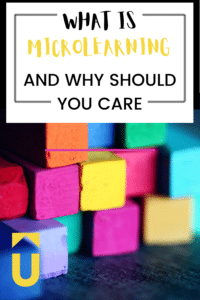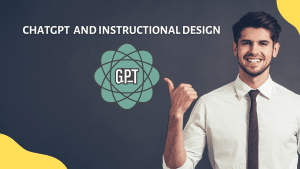Microlearning is a learning philosophy where a particular topic or area of study is broken down, where learners can learn with a razor-sharp focus in bite-sized parts
This post will talk about varying aspects of microlearning and how it can boost your organization’s learning competence or as an individual being able to learn in bite-size chunks from the comfort of your phone.
What is Microlearning?

Microlearning is the complete opposite of long-form courses (short-form I guess). It is about having short, bite-sized nuggets of information to give a learner the quickest way to understand information and be able to digest and apply what they have learned.
Another big element of Microlearning is time. An average of 3 minutes is about right, although Microlearning courses have been known to go up to 20 minutes but generally no longer.
The key is to get potentially complex information and make the learning process as quick and simple as possible and keeping it short and sweet is the best way to achieve this end.
Why use microlearning?
There are many reasons to use microlearning some of which we have listed below:
- Mobile accessible
- Quick
- Higher engagement
- More cost-effective
- Higher retention
The key element as to why use Microlearning is it is short, which allows for higher levels of engagement, it is to the point so unlike other longer online course content, e.g. traditional eLearning, learners will not get bored and by doing so waiver from the content.
Related: The Brain Science of Microlearning: Why It Works
You can provide a wide variety of topics and subject areas to your learners when using Microlearning formats, this could be text, imagery, video, audio, and more.
One of the biggest selling points of Microlearning outside of the reduced timescales is the ability to do it on your mobile device. The content is fully mobile responsive meaning the layout will completely shift to suit your device size and dimensions. This is very useful because it means this can be on-demand and allow you to view the content and learn in a variety of settings, even on public transit without having to have a heavy laptop with you all the time.
Microlearning can be achieved in pretty much any format, from Instructor-led (In-Person), virtual, traditional elearning, all the way to specific, dedicated Microlearning software like Talentcards.
Talentcards is a simple and easy way to engage learners with instructional content using the tried and tested method of flashcards. You usually would keep topic content very streamlined which allows for a simple step by step learning process.
Just to add some diversity, another great Microlearning tool to consider is Mlevel. This solution is more diverse than Talentcards as it doesn’t only use flashcards as part of it’s learning strategy, it gives you the option to integrate with other business products, e.g. HRMS or LMS, etc.
It also allows you to develop content in your authoring tool, whether that be Articulate, Captivate, or others, and import that content directly into the Mlevel mobile platform via SCORM. As well as this, you get a suite of analytics to manage and track user progress, gamification options to reward your learners with rewards, and also leaderboards and other social learning components to give your learners access to who is doing well to drive them to succeed. If you would like to learn more about Microlearning check out our post on the best Microlearning systems to use.
Check out a great Microlearning tool like MLevel
Why use Microlearning?
The key element as to why use Microlearning is it is short, which allows for higher levels of engagement, it is to the point so unlike other longer course content, e.g. traditional elearning, learners will not get bored and by doing so waiver from the content.
You can provide a wide variety of topics and subject areas to your learners when using Microlearning formats, this could be text, imagery, video, audio, and more.
One of the biggest selling points of Microlearning outside of the reduced timescales is the ability to do it on your mobile device. The content is fully mobile responsive meaning the layout will completely shift to suit your device size and dimensions. This is very useful because it means this can be on-demand and allow you to view the content and learn in a variety of settings, even on public transit without having to have a heavy laptop with you all the time.
Microlearning can be achieved in pretty much any format, from Instructor-led (In-Person), virtual, traditional elearning, all the way to specific, dedicated Microlearning software like Talentcards.
Related: Microlearning: Why you should try it
But wait, consider Talentcards
Talentcards is a simple and easy way to engage learners with instructional content using the tried and tested method of flashcards. You usually would keep topic content very streamlined which allows for a simple step by step learning process.
Just to add some diversity, another great Microlearning tool to consider is Mlevel. This solution is more diverse than Talentcards as it doesn’t only use flashcards as part of it’s learning strategy, it gives you the option to integrate with other business products, e.g. HRMS or LMS, etc. There are also many tools that offer functionality similar to Thinkific and its competitors.
It also allows you to develop content in your authoring tool, whether that be Articulate, Captivate, or others, and import that content directly into the Mlevel mobile platform via SCORM.
As well as this, you get a suite of analytics to manage and track user progress, gamification options to reward your learners with rewards, and also leaderboards and other social learning components to give your learners access to who is doing well to drive them to succeed. If you would like to learn more about Microlearning check out our post on the best Microlearning systems to use.
When can microlearning be utilized?
Microlearning can be used basically within any learning intervention but would be best utilized when you have a simple, linear topic that you want people to learn.
One thing about mobile learning and mobile devices in general, is if your course or program is too complex, e.g. has a lot of text-driven content like compliance, it can sometimes be overwhelming when viewing on a mobile device so my advice would be to keep it short and concise. Examples of how this could be used our “things to remember for internal communications” or a step by step process like “How to conduct CPR“.
When you need to roll out a more complex eLearning program you are probably best served to create this in a dedicated authoring tool like Articulate Storyline or a cloud-based variant like Articulate Rise to provide a more varied user learning experience.
What are the benefits of microlearning?
Although we have spoken about some of the benefits of microlearning already, I think it is wise to talk about them in a bit more detail.
Easier learning experience
Although we have spoken about some of the benefits of microlearning already, I think it is wise to talk about them in a bit more detail.
Cost-effectiveness and Agile
Overall, when you consider learning outcomes vs cost of introducing Microlearning platforms it is more cost-effective and better valuable for money than traditional eLearning and considerably cheaper than Face to face learning initiatives.
It also allows learning to be more agile, meaning that the courses can be introduced and rolled out very quickly and without a long, drawn-out development process.
Increased results
Considering how linear topics in Microlearning tend to be, it gives learners a more streamlined approach to achieve a specific outcome. This allows your learners to have a better application of what they have learned and when you evaluate the program you will see enhanced ROE (return on expectations) or ROI (return on investment) results.
Are there any limitations to Microlearning?
All in all, there are many more positives than negatives when it comes to Microlearning and how it can revolutionize a business or an individual’s learning needs.
One main limitation is Microlearning is as a method, it’s best used for a very specific, refined topic which can be limiting if you need to train or learn on a wide-reaching subject like a new software platform or in-depth regulatory compliance.
Mobile-first
Mobile learning is one of the greatest leaps forward in the last 10 years. It gives us the ability to have a more streamlined learning experience as well as being able to have on-demand content, to be learned in a self-paced manner that can be used whenever we have time, on a device we take with us every day.
As a learning strategy, more and more organizations are looking to have a mobile-first method. This gives more flexibility in how and where learning takes place and gives a unique way for organizations to train their employees which can be done even in off-hours (if contractually authorized).
Although not solely mobile, a great solution to also have a look at for mobile learning is Grovo. Consistently voted one of the best Microlearning platforms in the marketplace, it is definitely worth your time.
Microlearning leverages mobile devices in a way that offers a different user experience than on a desktop. Usually, desktops offer a much fuller experience that gives you all information you require as well as sometimes extra info that isn’t necessary to the task at hand e.g. learning a new topic.
5 benefits of mobile learning
- Easier to absorb information
- Able to learn anywhere with no time limit
- Increased flexibility
- Use a device you have all the time
- Responsive design
How to implement Microlearning
Microlearning can be very affordable and quick to implement under the right circumstances. The first part of the equation is to conduct a needs-based assessment to understand the learning requirements of your employees. If this comes back that strategic, simple topics are needed, then Microlearning may very well be the answer.
Secondly, conduct your research, ascertain if Microlearning can be supported and work in your organization, and find statistics that support the implementation of such methods as Microlearning and present this data in a meeting to your company executives as part of your assessment process.
The reason for this is you need to understand how much value your company puts into employee corporate learning and if it is a viable solution.
If this goes well you can start looking for a solution that will fit with your organization’s needs.
The great thing about Microlearning, is if you use a product designed specifically for this medium, they are almost all cloud-based meaning you can be up and running within hours.
Developing the content should be easy and if you are using a product like Talentcards, you can use the flashcard model which is very similar to using pins and boards on Pinterest which a lot of people will already know how to do.
Once you have your data from your assessment, you can now work on the fun part, designing your content. This can be very quick especially if you are using an agile learning model like SAM, but generally, you could have this content built within a couple of days things fall into place.
Remember, don’t forget to use an evaluation methodology like “The New World Kirkpatrick model” to assess how well it was received as a learning program and then how well that newly acquired knowledge was applied in general work.
Conclusion
So what is our conclusion on Microlearning?
Honestly, I would say if the results of your needs assessment warrant it, Microlearning can be an amazing method of employee training or learner engagement.
The thing is though, it only works effectively if the subject matter is not too long or complicated.
If you are needing a full elearning program for coaching employees about a new enterprise solution your company has implemented, you will usually want to look at a focused blended approach with elearning, software simulations, virtual learning, and in-person instructor-led approaches (if Covid-19 allows this).
If it is something simple like “how to improve your business writing” and you want to produce 10 simple steps to complete this task, using imagery, text, and multi-media formats, then this is where Microlearning can come into its own.
If you won’t have the funds to purchase a fully-fledged Microlearning platform, like Talentcards and Mlevel, that is fine, and you can produce this type of content using traditional elearning, even in-person training, but remember that 3 main elements make up a Microlearning course.
Short (Microlearning must be short and to the point)
Simple topic (the area of focus must be simple enough to be completed through Microlearning
Mobile accessible (being able to learn simple steps on mobile will increase engagement?
Hopefully, this post has given you some helpful hints and tips on understanding what Microlearning is, how to successfully implement a Microlearning strategy, and the benefits that be achieved from taking your learning strategy in this direction.

Hey, I’m Kris Taylor. I’m a Learning and Development professional currently in the healthcare field, with over 8 years of experience in the area of corporate education. I have created numerous instructional content for various corporate projects including eLearning, in-person facilitation, and virtual training across a wide variety of learning interventions and sectors. On Taughtup, I discuss topics ranging from how to succeed through K-12 to college all the way to instructional design tips for L&D designers.






